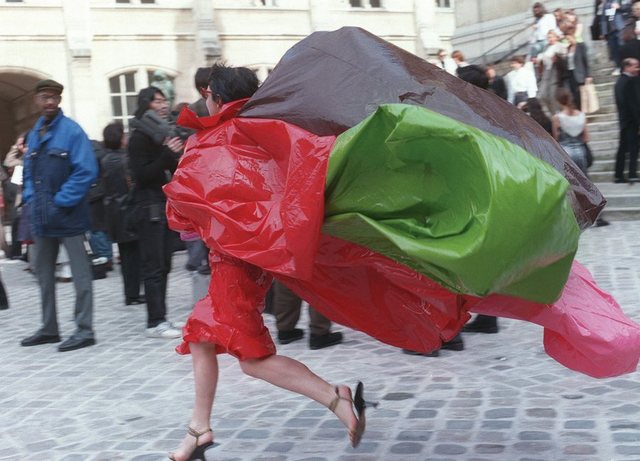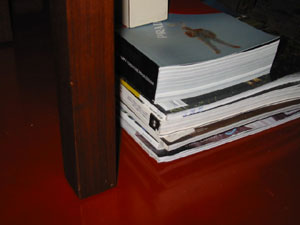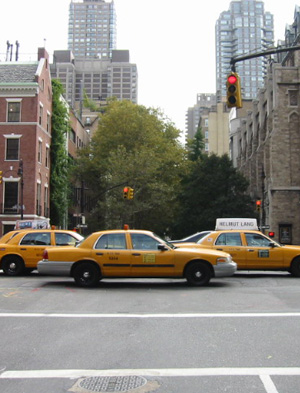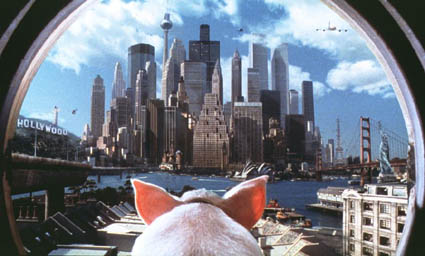It’s a phenomenon I’m well aware of, because I’ve done it myself. Even when I was growing up in North Carolina, my accent was never that strong; it certainly isn’t as strong as it is when I’m asking people in the South for something. Then, my accent deepens a bit, and I turn into Jethro Clampett before my traveling companions’ bemused eyes, a good old boy just trying not to get screwed at the rural gas station.
But I’m not the President of the United States. Bush very self-consciously hicks up his accent sometimes, for some reason(s) known to him. It should be researched, analyzed, and reported, but my theory is he does it only when he’s campaigning among the partisan faithful in certain states where he thinks Curiously Folksy George’ll play better (IA, NM, CO recently).
Want to try it out? Listen to this news conference with Chinese President Jiang Zemin from C-SPAN. Bush is in Crawford, but as soon as the mention of “the ranch…in Texas” is through, Bush goes nearly accent-free.
Now try this campaign speech in Alamogordo, New Mexico from NPR (the Bush story starts at 2:00), which is the strongest accent I’ve heard yet. [Note: NPR changed the stream. Now no audio/video of this stump speech seems to exist on the web. Why is that? It could be quite useful to hear politicians’ “entirely for local consumption” speeches repeated verbatim in multiple locations. “Sher am glad to be here in … Springfield with y’all”)
The Shawshank Effect, Bad Parking, and Esoteric Food
According to obviously not unbiased but nevertheless generally credible sources, Spike Jonze & Charlie Kaufman’s new film Adaptation is getting effusive response from preview audiences.
We saw the trailer for Adaptation; before the opening of Punch-Drunk Love, right after writing about the film’s just-launched weblog at SusanOrlean.com. Brimming with excitement for the film, anticipation building, the trailer made me want to run screaming from the theater. It was the worst trailer for a supposedly good movie since The Shawshank Redemption, which was almost buried by it’s horrible trailer.

< New Yorker Crankiness >: I hate amateur parallel parking, like the guy out my window this very minute, who just parked half a car-length from the sign and half a car-length from the next car. He even spent a few moments pulling up, backing up, focusing on getting straight and close to the curb, yet remained oblivious to his taking two spots. Even though Trent Lott wouldn’t approve, you could still fit a couple of Smart Cars in there. < /NYC>
Chowhound. I’ve been trying to remember this site, after hearing it on WNYC a few months ago. It’s the culinary findings of unnervingly energetic food fan Jim Leff, and it just turned up again on The Next Big Thing.
Buy This Book and Choose Your Friends Carefully

Production Still, Cremaster 2, 1999
Matthew Barney (photo: Peter Strietman)
Matthew Barney: The Cremaster Cycle, pound for pound, the most comprehensive Barney Book ever. (You won’t wonder why there’s no free shipping.)

The best line from the awards ceremony at the PBR World Finals Rodeo in Las Vegas: “Well, retirin’ your best friend’s like shootin’ your best horse.”
Real Men, Rank Bulls, Raw Sport (and Glidecam)
So I’m watching the PBR Bud Light Cup World Finals, and there’s a camera guy in the ring, all decked out like he’s, well, like he’s going to the biggest bullriding rodeo event of the year, thank you very much, and he’s got a Glidecam, just like we used in France.
But if you ARE complicit in the global fashion economy…
I know of at least one place where you can get Vitamin Water in Paris:
I forget the name, but it’s a clean little deli on Rue Danielle Casanova, just north (and just east) of Place du Marche Saint-Honore (that’s where the Commes des Garcons Perfume Shop is).
‘Well, you have to be a nut, kid.’

image of Isabella Blow in Yoshiki Hishinuma, by bill cunningham, via nyt 2002
“To be contemporaine de tout le monde–that is the keenest and most secret satisfaction that fashion can offer a woman.”
– The Arcades Project, Walter Benjamin
Apparent egalitarianism is the great appeal of the Street Fashion concept, especially in New York, and especially in the street photos of Bill Cunningham in the NYTimes. If you just be yourself –and that self is someone who’s got a bit of the trend radar that puts you in cargo pants about six weeks before it shows up in Cunningham’s Sunday street collages– your embroidered jeans-wearing booty may just surprise you by turning up in the paper. Bill never put your name under your photo, not even if yours is recognizable; credit goes to the man with the camera, and your just appearing is reward enough.
But when someone like Isabella Blow –who’s got “Muse” printed on her carte de visite –walks down the street, it’s the street fashion equivalent of George Bush making a speech in a national park: the setting says “See, I < heart > nature,” but be surprised if the clearcutters wait till FoxNews cuts back to the studio before revving up their chainsaws. Blow’s not on just anyone on any street any time. She’s a Muse. In Paris. During The Shows. Walking (or wafting, in this case) amidst photographers, designers, editors, stylists, and groupies. Fashion industry types. Just like her.
One of the designers Blow muses for is Jean-Paul Gaultier, who I once sat next to on the Concorde [that was totally uncalled for, I know]. Nice guy. And a brilliant miner of both the street-as-walkway and the street-as-runway. The Mixture, a new culture site with an old-school appreciation of editing, is streaming Gaultier’s latest show in its entirety. It’s worth watching.
Benjamin called the flaneur “a spy for the capitalists, on assignment in the realm of consumers.” If so, in the lead of France’s fashion industry (an “occult science of industrial fluctuations” if ever there was one. The Arcades Project is like a can of Pringles: once it’s open, you can’t stop at just one.) is just where Gaultier belongs.
France’s fashion week definitely has an industrial air, with trade associations, official this and that, and weighty government sanction. It’s like the Expositions Universelles that made Paris the center of the 19th century world, where innovations were unveiled: things like “electricity” (“The City of Lights”) and “Photography,” which debuted there in 1855. Benjamin again, on the group that re-defined the term, avant-garde:
The Saint Simonians, who envision the industrialization of the earth, take up the idea of world exhibitions…[They] anticipated the development of the global economy, but not the class struggle…World exhibitions glorify the exchange value of the commodity.
Nice work, if you can get it. Nobody knows better than Benjamin that the image and (the street) reality have a very complicated (business) relationship. When Bill Cunningham takes Isabella Blow’s picture on the street in Paris, we have to know that the image is manufactured, constructed in a myriad of ways, some obvious and some not, by all parties involved. (Isabella, even the panhandling woman in my neighborhood changes into her garbage bag before starting work.)
And I found the same issues face the filmmaker, even/especially the documentary filmmaker. To what extent do you just “let something happen” and you “happen” to film it? To what extent to you “make something happen,” or stage it? Can’t stage it? Wouldn’t be prudent? Wouldn’t have street cred? Well, how about if you just go to the spots where you know what you want to shoot is gonna happen? Then, you can just “happen” to film it. It all involves choices; editing before, during, and after the fact; having an eye (and a camera), and deciding what to do with it. All things being equal, then, some things just look better. And that can make all the difference.
The Age of Street Fashion [nyt]
On The Transformative Power of Architecture, or The Caribbean Light At The End of The Tunnel

image via globalsecurity.org
Last month I wrote about art and architecture made from connex containers, the standard 40-foot steel boxes used for international shipping. #1 architects MVRDV proposed a complex made from them for Rotterdam, their home town (and a major port). As the discussion on this architecture message board shows, container architecture is an idea with a lot of adherents.
Now you can add the Department of Military Aesthetics to the list. Containers were used to construct Camp Delta, the more permanent neighbor of Camp X-Ray, on the military base under US control (if not jurisdiction) in Guantanamo, Cuba. Here’s a description from Joseph Lelyveld’s very long NY Review of Books article about the quandary of the Guantanamo detainees:
Delta was thrown together for $9.7 million by a private contractor, Brown and Root Services�a division of Vice President Cheney’s old company, Halliburton�which flew in low-wage contract labor from the Philippines and India to get the job done, in much the same way that Asians were once brought to the Caribbean to harvest sugar cane. The cell blocks are assembled from the standard forty-foot steel boxes called connex containers that are used in international shipping: five cells to a container, eight containers to a cell block, with four lined up on each side of a central corridor where the lights and fans are installed. Welders cut away three sides of each container, replacing them with sidings of steel mesh, leaving the roof, floor, and one steel wall into which a window was cut. Floor-level toilets were installed�the kind requiring squatting, traditionally described as � la turque�and now these are sometimes mentioned as an example of American sensitivity to the cultural needs of the detainees.
“Alone, nothing, together, a household word, a legend”
Even though I’m on the record (ad nauseum) as hating musicals, it’s probably more accurate to say I hate most musicals or bad musicals. The shows I’ve seen by Adolph Green, who collaborated for sixty+ years with Betty Comden, don’t fall into either category. Unbenknownst to me, they were sitting right in front of me at The Public Theater’s 1997 revival of On The Town; right before the show started, an announcement was made and they stood to accept a round of applause. It was the first show for Comden, Green, Jerome Robbins and Leonard Bernstein.
In mid-November, Singin’ In The Rain is screening at Film Forum in a new 35mm Dolby Stereo print. Adolph Green died today at his home in Manhattan.
Tilting at Windmills: Script Annotation and PR for Souvenir Premiere

Have spent most of yesterday and today writing, researching, annotating the AM script. As discussed before, it’s based partly on a real-life crime story, so it’s critical from a CYA standpoint to document the sources of characters, facts, events, and evidence in the publically available record. It’s a rather laborious process, but fortunately, I’ve kept a fairly comprehensive file of source material for the last 2+ years. Obviously, I didn’t imagine using it for a movie–much less an animated musical–until very recently. And to those with deep misgivings about an animated musical based on a true-crime story, bad Star Treks, The Umbrellas of Cherbourg and Citizen Kane, I say, welcome to my world.
In addition, I’ve been working on updated press kits, press screening copies of the movie, prouction stills, mailing lists, bios, PR ideas, and other planning for the MoMA Documentary Fortnight premiere. The Museum’s releasing the full list of films to be screened this week. Stay tuned. And if you have any ideas or comments on PR/press, please chime in.
Gallery and Museum Picks So Far

Untitled (Two Windows), 2002, Toba Khedoori
Drawing Now: 8 Propositions at MoMAQNS, for Toba Khedoori, Chris Ofili, Russell Crotty, Paul Noble, Kai Althoff [Roberta Smith’s NYTimes review; Walter Robinson’s artnet review] [There’s a Toba Khedoori show at David Zwirner right now, too.]
Lazlo Moholy Nagy Color Photographs at Andrea Rosen Gallery: They look like they were made yesterday, not in the ’30’s/’40’s. (Actually they were. Moholy Nagy’s estate had them printed for the first time ever. Liz Deschenes did the printing. They’re amazing and exquisite.)
Staged/Unstaged at Riva Gallery: for (Souvenir cinematographer) Jonah Freeman’s entrancing new video work and a funny video piece by Maria Alos. Curated by Lauri Firstenberg. Chris Ofili and his crew climbed 11 flights of stairs for the sweaty opening.
The (S) Files Bienal at El Museo del Barrio: It opens tonight, but I figure if there’s a little portrait of me by Maria Alos in the show, it must me good.
Shmoology at M3 Projects in Dumbo: Curated by Bill Previdi, who’s 3 for 3 on shows he’s done that I’ve seen. Go now. Ends this weekend.
Uta Barth at Tanya Bonakdar Gallery: for the photographs of the spaces between–sometimes between the camera and the background, this time between the branches out the artist’s window.
Karen Kitchel at Cornell deWitt Gallery: for crisp, precise, beautiful paintings of grass.
Martin Creed at Maurizio Cattelan’s Wrong Gallery: for something to talk about, since a lot of people are talking about it. [Same Walter Robinson review as above, just scroll down.]
On Rem’s Ideas of Verticality and Shopping

Rem Koolhaas’s Projects for Prada, Part 1, underneath a table-like sculpture by Wade Guyton
From the NY Post:
Firefighters had to rescue shoppers from a stuck elevator in the super-trendy Prada store in SoHo the other day. A mother and her two young daughters were celebrating one of the girls’ birthdays at the Rem Koolhas [sic]-designed boutique at around 4 p.m. when they entered the high-tech, round glass elevator. The thick double doors jammed, trapping them inside for an hour and a half with a mannequin dressed in a see-through plastic raincoat. Since Koolhas neglected to include an escape hatch, the FDNY used a power saw to cut a hole in the steel roof big enough for a ladder. The store was closed for 45 minutes while sparks flew and onlookers gawked from the sidewalk. The apologetic manager presented the liberated shoppers with free cosmetics.
Prada representatives have not responded to requests for confirmation/information, and store employees have been asked not to comment.
For more of Koolhaas’s views on current trends in retail, check his two most recent publications: The Harvard Design School Guide to Shopping and Projects for Prada Part 1. stay tuned. [I particularly recommend the Prada book.]
On Reading (Between) the Lines

Thinking about Koolhaas’ Delirious New York again. This 1978 book, billed as a “retroactive manifesto,” tells the story of Simeon deWitt, Governeur Morris and John Rutherford, who boldly mapped out the Manhattan Grid in 1811. “…Each block is now alone like an island, fundamentally on its own. Manhattan turns into a dry archipelago of blocks.” The grid set the terms for Manhattan’s future and foreordained–according to Koolhaas–NYC’s vertical development (ie., the skyscraper). Apex Art had an interesting exhibit in 2000, “Block,” which featured Austrian architecture students’ responses to what Koolhaas called “Manhattanism.”
My street was barely a twinkle in deWitt & Co’s eyes then. In fact, the two buildings above both date from the 1920’s, when Park Avenue got its first real upgrade (from putting the NY Central railroad below grade. It’s the train to New Haven, you know). But like the rest of Manhattan, it’s character is inexorably derived to the grid. But not in the way Koolhaas thought. It’s the street, not the block, that’s really wonderful. On approach my street’s most interesting feature is the forest-dense trees that fill the space between the blocks.
John Cage was interested in the spaces between, whether between sounds or between notes or text on a page. It’s one of the reasons I wanted to use Cage’s music in Souvenir (November 2001). And Gustavo Bonevardi, a creator of Towers of Light (a project which played a role in my writing Souvenir and which has an indirect reference in the movie) said of it: “…in effect, we’re not rebuilding the towers themselves, but the void between them.”
How To Tell Me and Brad Pitt Apart
 Took a whirlwind trip to the Yale School of Architecture to see an exhibition (mostly) of the theoretical works of the Rotterdam architecture firm, MVRDV. Ivory tower academics? Nope. They actually build. A lot. And Yale dean Robert Stern rightly praises “their belief that invention grows out of knowledge is refreshing in a profession too often mired in fashion.”
Took a whirlwind trip to the Yale School of Architecture to see an exhibition (mostly) of the theoretical works of the Rotterdam architecture firm, MVRDV. Ivory tower academics? Nope. They actually build. A lot. And Yale dean Robert Stern rightly praises “their belief that invention grows out of knowledge is refreshing in a profession too often mired in fashion.”
Through projects like Metacity/Datatown to Pig City to the 3D City Ballet, the firm’s just-the-facts analytical approach to the problems of urban density have yield results that are inventive, increasingly sophisticated, and, yes, beautiful. It’s fitting that the exhibit’s in New Haven; after all, what is Connecticut, but a classically American “approach to the problems of urban density”? MVRDV’s never met a sprawl it didn’t want to render obsolete. Their “more-in-less-space-is-more” love of the city can be attributed in part to their early tenure with Rem Delirious New York Koolhaas (they were over him before he was ever kool). But it’s also the hardearned appreciation of space that comes from living in a country which, according to Nature’s logic, should be entirely underwater.
MVRDV’s most-discussed theoretical project is Pig City, their turns-out-to-be-explosively-controversial proposal to concentrate Holland’s massive (and land-intensive) pork industry into self-contained skyscrapers. The Dutch architecture site Archined has many heated comments about Pig City’s moral/ethical implications.
Although Winy Maas (the M in MVRDV) told me about it in May, I didn’t write about it here, but Pig City (and the firm) got caught up in the political upheaval and violence that shocked the Dutch last Spring. Pim Fortuyn had appropriated Pig City into his right-ist party’s platform. The dam on the lagoon broke when Fortuyn was assassinated by an leftist (and animal rights activist), and Winy & Co. were faced with unexpected censorship and death threats.
America’s probably a vapid, welcome respite for these guys. While a suburbanite couple in the gallery with me today sniffed, the guestbook was full of celebratory comments. Winy’s gonna have groupies, too; he’s taking the Eli’s through the (s)paces next Spring, studying the urban mechanisms of New York.
All nice, but they also enjoy America’s greatest reward for the contemporary architect, the adulation of Hollywood celebrities. Architecture writer David Sokol, reports in Metropolis (three times!) that “MVRDV, in case you haven’t heard, is actor Brad Pitt’s favorite architecture firm.” Actually, no, I hadn’t heard, so I looked it up. According to The Pitt Center, MVRDV are only Pitt’s third favorite architects (after Gehry and that damn Koolhaas, FYI). Brad say’s they’re #3, I say they’re #1. Write that down.
Weblogging from the Pop!Tech Conference
“Great web philosopher” David Weinberger weblogged several talks at PopTech 2002, which had the theme of Artificial Worlds. From his posts, it sounded like a lot of thought-provoking fun. But what’s in it for me you ask? (Me meaning me, of course, not you.) Some speakers addressed stuff that matters to the Animated Musical (which now has a future-based flashback-to-the-present structure, as noodled over here):
Bonus Weinberger question: “I said last summer I stood in a wheatfield that 100M stalks of wheat. If we take left-leaning is on and right-leaning as off, for 5 minutes, that wheatfield completely represented Casear’s brain state when he was stabbed. So, I asked, it seems to me that hw-sw is entirely the wrong paradigm for the brain, intelligence, consciousness. (Unfortunately, I chose not to draw the explicit connection, in order to save time, and thus sounded like a lunatic.) “
Bonus outside reading assignment: Dr. Antonio Damasio’s The Feeling of What Happens: Body and Emotion in the Making of Consciousness
Bonus video game-as-research:The Sims, duh, and Grand Theft Auto 3 (“reprehensible” but “revolutionary”).
Pseudonyms
Not being a rabid fan of Hunter S Thompson, Jerry Seinfeld, Beck, Leno, or their literary agents, I somehow missed the original brouhaha about Asterisk, the pranksterish pseudonym of some reasonably well-known writer/comedic person (rumors have/had it to be either Thompson himself or Jerry Seinfeld).
A rant-filled fax sent–seemingly from HST–to HST’s agent complained that some Asterisk was ripping HST off, but it turns out the fax itself was from Asterisk in the style of HST. Anyway, now 3AM Magazine has an interview with the as-yet-unidentified Asterisk. The Beck connection? A Spike Magazine reader named Andreas Gursky [thunk! Um, Spike, I think you dropped something.] pointed out a Fimoculous anecdote where Beck asked Seinfeld who Asterisk is during a taping of Jay Leno.
As a media circle jerk, it’s a bit tiresome, but because The Animated Musical has some pseudonymous characters in it, the idea’s been on my mind. Recently, a greg.org reader and very respected editor [thunk!] suggested I employ a pseudonym to write on topics other than my film projects. With the advent of online communication, pseudonyms aren’t just for Deep Throat anymore. In a world of complete Googlability, compartmentalizing one’s thoughts/activities/output is probably not all bad. But after you’ve admitted you liked Star Trek: The Motion Picture, I figure there’s nothing left to hide.
